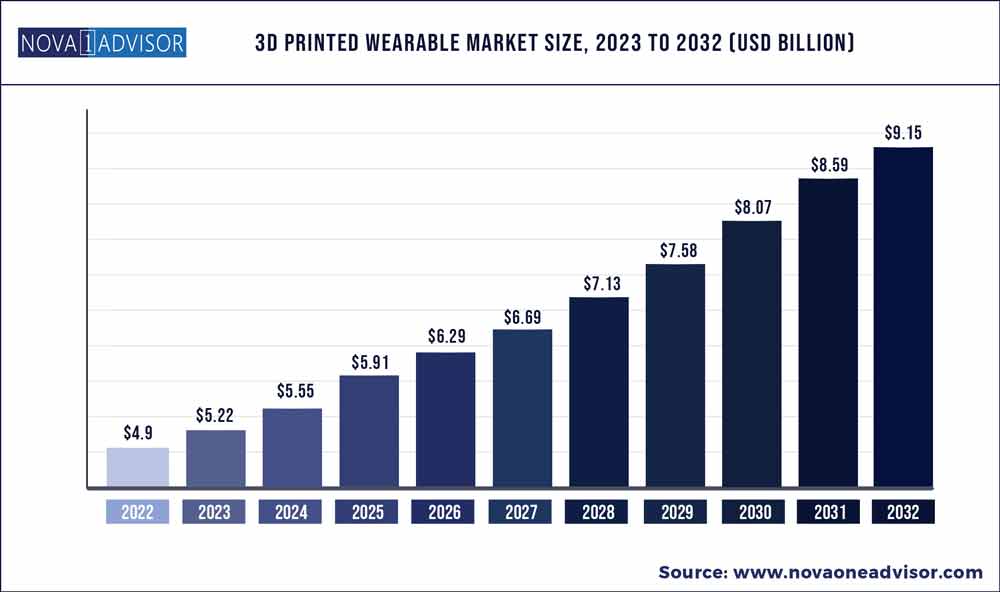The global 3D printed wearable market size was exhibited at USD 4.9 billion in 2022 and is projected to hit around USD 9.15 billion by 2032, growing at a CAGR of 6.44% during the forecast period 2023 to 2032.

Key Pointers:
- North America dominated the market and accounted for a revenue share of over 41.0% in 2022.
- The prosthetics segment accounted for the largest revenue share of over 36.1% in 2022.
- The hospitals segment accounted for the largest revenue share of over 36.1% in 2022.
3D Printed Wearable Market Report Scope
|
Report Coverage
|
Details
|
|
Market Size in 2023
|
USD 5.22 Billion
|
|
Market Size by 2032
|
USD 9.15 Billion
|
|
Growth Rate From 2023 to 2032
|
CAGR of 6.44%
|
|
Base Year
|
2022
|
|
Forecast Period
|
2023 to 2032
|
|
Segments Covered
|
By Product Type, By End-User
|
|
Market Analysis (Terms Used)
|
Value (US$ Million/Billion) or (Volume/Units)
|
|
Regional Scope
|
North America; Europe; Asia Pacific; Central and South America; the Middle East and Africa
|
|
Key Companies Profiled
|
General Electric (GE) Co., Everist Health, Inc., Medtronic PLC, BioTelemetry, Inc., Koninklijke Philips N.V., Omron Corporation, Cyfuse Biomedical K.K., Under Armour, Inc., Nike, Inc., 3D Systems Corporation and Others.
|
3D printing technology involves the manufacturing of medical devices and other products layer by layer. The rising emphasis of market players on manufacturing 3D printed wearable products is estimated to boost the growth of this market. As recently established 3D printed wearables are anticipated to overcome the shortcomings of conventional products, 3D printed wearables sales are expected to rise shortly.
The COVID-19 pandemic had significantly affected the transportation and logistics of the raw materials of 3D printed wearable products. The global supply chain was disrupted during the first half of 2020 due to the lockdown and COVID-19 restrictions in various regions. As a result, market players have witnessed a decrease in the sale of 3D printed products. The FDA took flexible approaches to ensure the availability and resolve the critical supply chain shortage of 3D products such as 3D printed PPE suits for healthcare workers. By the end of the third quarter of 2020, the sale of 3D printed products started increasing as the need and demand for the products increase with an increase in the awareness regarding the product among the consumers.
The major factor driving the market for 3D printed wearables is the increasing demand for uniquely designed products. With the help of 3D printing, companies can design a device as per customers’ requirements. Additionally, the factors driving the market are the increasing focus on health by consumer technology companies and the general public. For instance, with the help of 3D printing technology, sports manufacturers have to produce shoe soles that increase diabetics' sensory perception. With the help of these shoes, diabetic patients can walk more comfortably and these shoes can also be custom designed for each patient.
The 3D printed wearable devices can collect information including the step count a person has walked in a day and the pulse rate. The research within the technology is presently intensive on sensors and flexible materials and their ability to be both bendy and pliable. These properties are perfect for wearables, particularly in products such as small discrete sensors and smartwatches. Additive manufacturing, also known as 3D printing, is regarded as the next industrial revolution in manufacturing, with a high potential to provide cost-effective methods to achieve complex and customized medical components and parts, such as organs, orthopedic and cranial implants, tissues, and dental prosthetics.
Some of the prominent players in the 3D Printed Wearable Market include:
- General Electric (GE) Co.
- Everist Health, Inc.
- Medtronic PLC
- BioTelemetry, Inc.
- Koninklijke Philips N.V.
- Omron Corporation
- Cyfuse Biomedical K.K.
- Under Armour, Inc.
- Nike, Inc.
- 3D Systems Corporation
Segments Covered in the Report
This report forecasts revenue growth at global, regional, and country levels and provides an analysis of the latest industry trends in each of the sub-segments from 2018 to 2032. For this study, Nova one advisor, Inc. has segmented the global 3D Printed Wearable market.
By Product Type
- Prosthetics
- Fitness Trackers
- Surgical Instruments
- Orthopedic Implants
- Smart Watches
By End-User
- Hospital
- Academic Institutes
- Pharma & Biotech Companies
- Others
By Region
- North America
- Europe
- Asia-Pacific
- Latin America
- Middle East & Africa (MEA)

